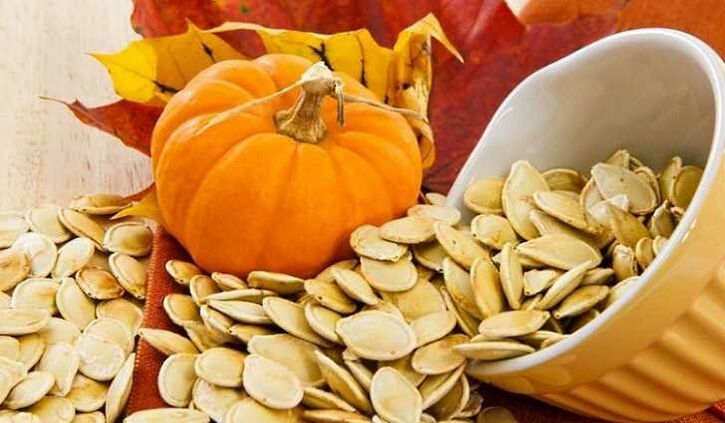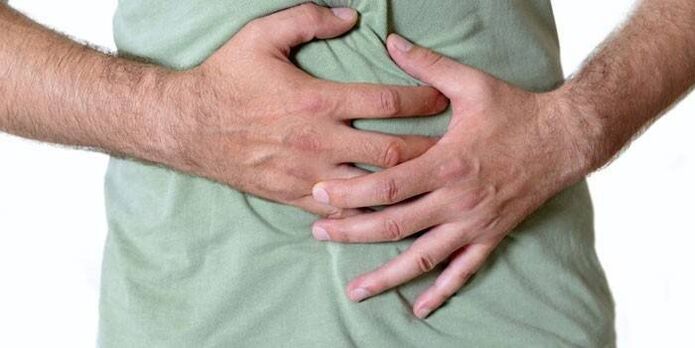The worm infestation does not go unnoticed. Of course, there are cases where the invasion occurs in a small number of individuals and, obeying all hygiene rules, they survive life and disappear asymptomatically. However, this happens very rarely, in general, the symptoms of helminthiasis are very pronounced and we cannot fail to pay attention to them:

- Pain in the umbilical region and right hypochondrium, profuse salivation, nausea, vomiting, irritated stools.
- Various allergic reactions of the broadest spectrum: hives, dermatitis, itching, edema.
- Symptoms of pneumonia, bronchitis, shortness of breath, recurrent asthma attacks, coughing with phlegm, sometimes blood may be present in the phlegm.
- Headaches, dizziness, fainting, pseudo-epileptic seizures, sleep disorders, irritability.
- Weakness, hypotension, chronic fatigue, mood swings.
The prolonged presence of worms in the human body can cause irreparable damage to health and cause the development of serious complications: from loss of vision to autoimmune alopecia (baldness).
Important points of treatment for parasites
- Remove confectionery, baked goods and sweets from the diet during cleaning and treatment and then reduce the amount of sweets consumed - this is a breeding ground for parasites.
- Cleaning the body of parasites should affect all family members and pets. Simultaneously with the treatment and cleaning, they perform a "general" cleaning of the house, wash towels, bedding, underwear, wash all children's toys, cutlery.
- Cleaning the body of parasites with some popular recipes, means, drugs - it is contraindicated for pregnant women, nursing mothers, people suffering from heart disease, stroke, heart attacks.
- The use of any cleaning product from traditional or popular medicine should be discussed with a doctor, especially for children.
- In combination with cleaning medications, by popular methods, it is advisable to use sorbents, antiallergic medications, because during death the parasites release a large amount of toxins in the human body.
First rule: confirm the diagnosis
How to remove worms from the human body? All the symptoms of helminthic invasion are very similar to the symptoms of other diseases. According to them, it is impossible to say with certainty that unwanted guests have settled in the body. Perhaps the set of signs by which you decide you have worms are actually symptoms of other illnesses. Therefore, if you suspect helminthiasis, see a doctor and get tested.
For laboratory confirmation of helminthiasis, the following can be prescribed:
- Complete blood count.
- Stool analysis for worm eggs.
- ELISA blood test for antibodies to worms.
If the diagnosis is confirmed, the doctor will prescribe not only a medication, but also, depending on your condition, an additional treatment: immunomodulators, vitamins, adsorbents, iron preparations.
Diet and prevention of helminthiasis
Anthelmintic therapy should always be comprehensive. Therefore, in addition to taking medication, you also need to follow a special diet. If the blow has hit the liver, you should limit the use of fatty foods.
Eat as many different fruits and vegetables as possible. They will help to strengthen your immune system. Castor oil, nuts and coconuts help to fight parasites. You need to eat fractionally: more often, but in small portions.
To prevent the development of helminthiasis, you must follow the rules of personal hygiene. Meat and fish must be properly cooked. It is advisable to use only filtered or boiled water. You must not swim in muddy waters. It is best to avoid contact with stray animals.
How to get rid of worms
Perhaps the circumstances have developed in such a way that at the moment it is not possible to go to the doctor, and you know for sure that you have worms. So, it is worthwhile to resort to popular methods of treating worms. Vegetable raw materials, which are used for decoctions and infusions, contain biologically active substances, which will help to effectively remove worms from the body. In Asian countries, for the prevention of various types of helminths, a large amount of spicy red pepper, ginger and garlic are used in food. How to remove worms from the body with folk remedies?

- Absinthe infusion.Absinthe is an excellent anthelmintic agent, the main thing is not to increase the dose of plant-based raw materials: an overdose can lead to poisoning. Prepare 15 grams of absinthe with boiling water in a liter container and let it infuse under the lid until it cools. Strain and drink 1/2 cup before meals several times a day.
- Infusion of tanasis.Tansy is an excellent remedy to remove parasites and worms from the body. Pour a spoonful of tansy flowers with boiling water into a liter container, leave for 4-5 hours, squeeze out the raw material. Drink several times a day, single dose - 15 - 20 ml. From tansy, you can make a composition for an enema, which will help get rid of pinworms: pour a tablespoon of tansy flowers with a glass of boiling water, let it cool to body temperature.
- Pumpkin seeds.Raw pumpkin seeds are a well-known anthelmintic and can even be used by pregnant women. Grind the pumpkin seeds with 2-3 cloves in a coffee grinder and pour into a jar. Take one tablespoon 3-4 times a day for two weeks. You can simply gnaw the seeds: a handful of pumpkin seeds 2 to 3 times a day - and you will forget the worms forever.
- Garlic.The most effective remedy is considered a garlic enema: for 150 ml of hot milk, 5-7 crushed garlic cloves. Insist under the cover until it cools. For internal use, a decoction of garlic and onion is made: in a glass of hot milk, crushed an onion head and some crushed garlic cloves, insist until cool under a lid. Take 1/4 cup several times a day.
- Mushrooms.Few have heard that chanterelles contain a powerful antiparasitic substance in their composition. For the treatment of worms in adults, it is a wonderful folk remedy. Chanterelles are salted, dried and harvested in every possible way, so the medicine is always at hand. For a glass of vodka, you need 40 grams of chopped fresh chanterelles and 45 grams of dry. The composition is infused for 2 weeks in a dark, cold place. When you're ready, take 1 teaspoon at bedtime.
- Troichetka.The so-called triad is a composition of three herbal remedies that has a good anthelmintic effect. Wormwood, tansy flowers and fresh carnations are ground to a powdery state. Combine in proportion: 0, 3 parts of absinthe, 1 part of tansy, 1, 5 parts of powdered cloves. It is taken as follows: the daily dose of absinthe should not exceed 1 gram, tansy - 3 grams, so the dosage is calculated based on these restrictions. The powder can be swallowed with water, divided into three doses a day. The course of treatment is up to 2 weeks.

The treatment of worms in humans with folk remedies is very light. They do not have a large number of side effects, toxic effects on the liver and are capable of handling even serious worms. For the prevention of helminthiasis, you cannot think of a better remedy: if you drink an infusion of tansy every six months or regularly gnaw on tasty pumpkin seeds, you will forget about problems like worms.
What are worms
Helminths (worms) - general name for parasitic worms, whose owner is a person or an animal. Currently, there are more than 250 species of helminths on the planet (about 90 of them live in the CIS). In length, the worms in the human body can reach several meters, but most are 20-40 cm in size. Helminths are able to inhabit almost all organs of the human body, feeding on the host's internal resources, weakening it and leading to the development of diseases.
The peculiarity of helminths is that their complete life cycle cannot occur in the host's body - conditions that are not specific to the human body are necessary for the maturation of eggs. The prolonged presence of worms is due to reinfection (ingestion of ripe eggs in the mouth and then in the stomach and intestines). After helminth eggs enter the human body, the larvae emerge from them and begin to move around the body. Most helminths "live" in the intestines, but some types of worms are able to migrate with the bloodstream to other organs (lungs, liver, heart, brain, eyes).
In the process of infection and later development in adults, worms in the human body have the following pathological effect:
- mechanical violation of the integrity of the intestinal wall;
- exposure to toxic helminth residues;
- absorption of useful substances necessary for a person by the parasite;
- closure of the liver ducts, intestinal lumen with lumps of worms (rare in cases of large helminth lesions).
Helminthiasis is a group of diseases caused by helminthic invasions. Children are more susceptible to these pathologies, as their immunity is not yet fully formed and, in addition, they are unable to take care of personal hygiene on their own. Further away from the child, it is possible to infect adult family members, which contributes to further dissemination.
In helminthiasis, specific symptoms are not characteristic, as the clinical picture of worm infection is similar to the signs of pathologies of the gallbladder, liver, gastrointestinal tract, so laboratory tests are necessary to establish an accurate diagnosis. In addition, an asymptomatic carriage is often found, the diagnosis of which is associated with certain difficulties.

Views
Helminths are divided into three large groups based on morphological characteristics: round, tapeworms and flatworms. Each category is subdivided into several classes. Helminthiasis is grouped according to the type of worm that causes the disease. Characteristics of varieties of helminths and the pathologies they cause:
- Roundworms (nematodes) are heterosexual helminths of relatively small size (2-40 cm), are common due to the ease of transmission. Nematode infection occurs when the parasites' eggs enter the host's mouth through the carrier's feces. The most common representatives of helminths are oxymorons - they are infected in 90% of cases. Moth larvae cause enterobiasis, accompanied by severe exhaustion, disorders of the gastrointestinal tract. The second most common helminthiasis is caused by the ascaris worm and is called ascariasis - it is a pathology in which parasites infect not only the human intestine, but also other organs (liver, lungs, heart). Ascariasis can cause internal bleeding, the appearance of allergic reactions, in children - developmental delay. The so-called tricurid, despite its small size (3-5 cm), can have a toxic effect on the human body for 5 years, causing the disease tricocephalose. The influence of Trichinella worms leads to the development of trichinosis, a characteristic that is the damage to muscle tissue.
- Tapeworms (baskets) are the largest representatives of helminths (10-15 meters). These are parasites of the same sex, that is, their reproduction is performed by a single individual. A mandatory stage in the tapeworm life cycle is the development of ungulates in the body. Basket eggs enter the environment in the feces of host animals. In addition, infection with contaminated meat is possible. For example, insufficient heat treatment of pork leads to infection with the pork tapeworm, bovine - with the bovine tapeworm. Echinococcosis, caused by echinococcal worms, for which a person is an intermediate host, is considered a serious parasitic disease. This pathology leads to the formation of cysts in the organs, which can only be eliminated with the aid of surgical intervention.
- Flatworms (trematodes) are small (7-30 mm) and usually infect the liver and bile ducts. Trematosis can lead to the development of hepatitis, cholelithiasis. The main characteristic of flatworms is the presence of sprouts on the surface of the body, which serve to absorb nutrients and blood. Trematode infection occurs as a result of eating undercooked or undercooked fish and seafood. The main representatives of trematodes are hepatic worms and schistosomes; the first cause of opistorrchiasis, the second - schistosomiasis.
A separate niche between parasitic invasions is occupied by protozoan infections caused by protozoan unicellular microorganisms. The reproduction of these parasites occurs due to the division, therefore, their number increases rapidly. The most common type of unicellular parasite in our region is lamblia, it exists in two forms - vegetation and cysts (spores). According to statistics, one in three children in Russia suffers from giardiasis, since the infection occurs when only 2-10 lamblia cysts enter the intestine.
- Vapor barrier for the walls of a wooden house.
- Eco-leather - what kind of material is this with the photo? The properties and characteristics of ecological leather, how to differentiate it from genuine leather.
- How to get rid of foot calluses at home.
Reasons
Infection with helminth and protozoan invasions is carried out via the oral-fecal route - mature eggs or spores enter the host's mouth and the feces intestines of infected animals. Science knows four main forms of infection:

- Contact - made when a person comes into contact with an infected carrier (animals, birds, another person), leads to the development of contact helminthiasis.
- Infection with soil and water, which contains disease-causing eggs or cysts, causes geohelminthiasis.
- The infection that occurs when eating meat and fish that are raw or insufficiently treated with heat leads to the development of biohelminthiasis.
- A small percentage of infestations are caused by insect bites.
What are the contraindications

Like all biologically active agents, herbal anthelmintic drugs can cause an allergic reaction. So be careful when starting treatment. Especially active herbs, such as wormwood or tansy. They contain substances that, in the event of an overdose, can cause poisoning. In addition, absinthe and tansia are contraindicated for use in people with gastrointestinal diseases, gastritis, erosions and ulcers.






































